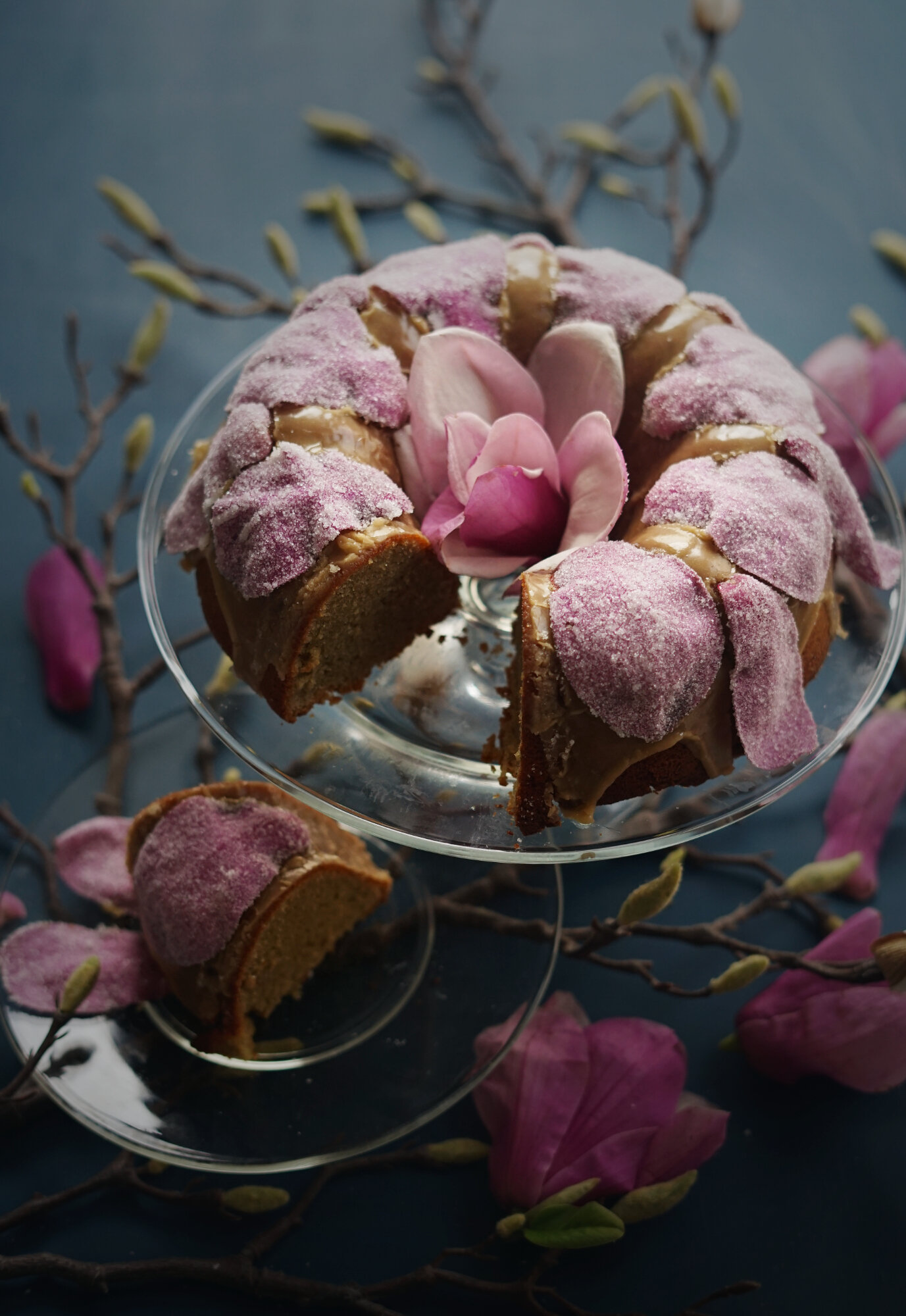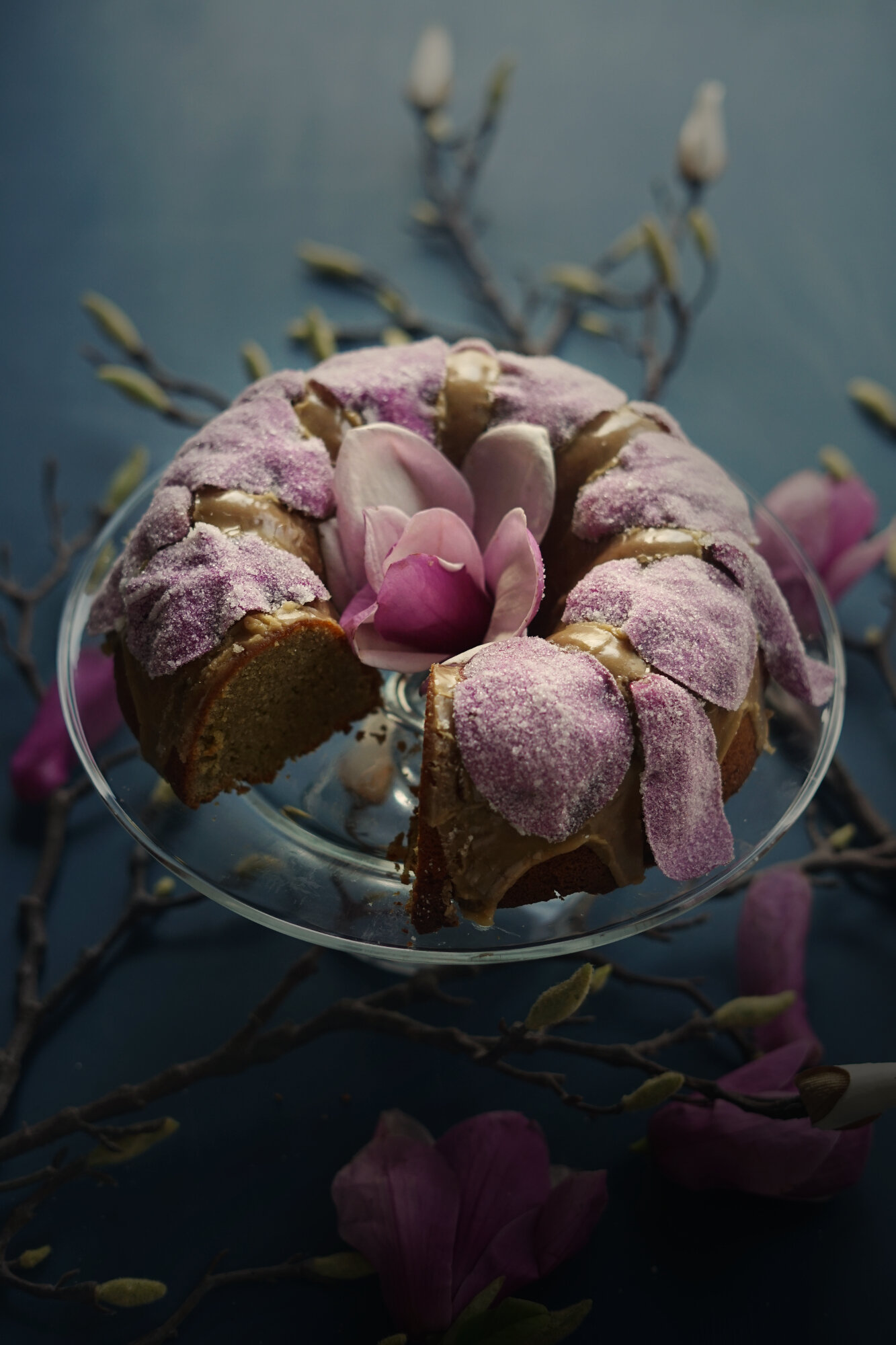Magnolia Magic: Caramel Magnolia Bundt Cake
New to foraging? Learn more about ethical and safe foraging (plus how to get started) here!
I’m suspended in time, swimming through a primordial sea under foot. The hard strata of stone softens into silky fluidity as I move through the earth, surrounded by giant trilobites and other prehistoric relics. As I slowly wake up, I’m a magnolia flower, layers of petals gently unfurling as my consciousness returns, a measured emergence of awakeness. I blink my eyes groggily and reflect on my dreamed experience.
Magnolia trees are one of the most beautiful sights this time of year. Their impressively-large blossoms add color and texture to the scenery, plus a bewitching spicy fragrance. Every time I am in the presence of magnolias, I can’t help but feel like I am tapping into some really ancient magic. There’s a reason for that - magnolia trees have been around for a long, long time - about fifty million years. These incredible plants are ancient, enduring, steady. Their thick blossoms evolved to survive the giant beetles that were their first pollinators, long before smaller insects could be found on earth. Their formation is a reflection of some of the very first flowers. So early, in fact, that they don’t even have petals. Instead, the petals and sepals are the same, so they are referred to as “tepals” botanically.
Since the Eocene period, magnolias have persevered. Though they do not cover quite so much ground as they did in a period of warmer temperatures on Earth, they are still plentiful. As a symbol, they represent resiliency and nobility. It’s easy to see why; these stunning blossoms seem to rule the landscape this time of year. Long ago, they may have seemed to rule the planet.
Some species of magnolia are native to North and South America; others hail from the Himalayas and East Asia. Certain hybrids are now popular for landscaping and garden planting. You probably won’t find a magnolia tree growing in the wilds of the Pacific Northwest, but you’ll likely find them punctuating the urban landscape. They are a wonderful excuse to talk to your neighbor as you ask permission to gather just a couple of those gorgeous big blooms.
Different species of magnolia have different flavors. All are edible, though I would encourage you to go slow. Like any other plant, you may have an allergy or intolerance. Remember that these are a plant for grazing - a little here, a little there. You wouldn’t want to eat a big salad of just magnolia tepals anyways - they have quite a strong and spicy flavor! I find that flavor utterly enchanting, like a floral ginger mixed with a bit of black pepper and a resinous piney aftertaste. I fell in love with magnolias this year. After a morning of nibbling petals and dreaming, this delicious and simple cake was born.
Magnolia Caramel Bundt Cake:
This gluten and dairy-free cake is soft and moist, and the uniquely delicious flavor of magnolias really comes through! The other secret ingredient is mellow miso paste, which adds just a bit of umami to the batter. Then the cake is coated in a delicious salted caramel glaze and topped with giant candied magnolia petals for even more magnificent flavor! And as magnificent as this cake looks, it’s actually very simple. The batter takes just moments to mix up, and the petals are quickly candied while it bakes. The glaze comes together easily while the cake cools, and then you just have to assemble everything! It also has an incredible shelf life for a gluten free cake ; even on day three, this cake is still soft, moist, and absolutely delicious. (I can’t tell you how it is on day 4 because my self-control just didn’t last that long…)
Magnolia Cake:
2/3 c. almond milk
1 c. magnolia tepals (petals)
1 ½ c. gluten-free flour (*my mix is equal parts by volume of tapioca starch and white rice flour, plus 1 tsp. xantham gum for every 4 cups of mixture, whisked in well.)
1 ½ c. almond flour
¼ tsp. Ground dried ginger
⅔ c. dairy-free butter, at room temperature
1 tsp. Sweet chickpea miso
1 ½ c. granulated sugar
2 tsp. Baking powder
1 Tbs. Vanilla bean paste
5 large eggs, at room temp.
Candied Tepals:
16 magnolia tepals
1 egg white
1 tsp. Vodka
Granulated sugar
Glaze:
½ c. dairy-free butter, at room temperature
¾ c. brown sugar
3 Tbs. almond milk
2 c. powdered sugar
Directions:
Preheat oven to 325F. Thoroughly grease a 10-cup bundt pan.
Put the almond milk and magnolia tepals in a blender and blend until smooth. Set aside.
Whisk together the flours and ginger in a medium bowl.
In another bowl, beat together the butter and miso. Add the baking powder, vanilla, and sugar and beat until smooth and fluffy, scraping the bowl a couple of times to make sure everything is incorporated. Add the eggs, one at a time, beating well after each addition so that the mixture is light and fluffy.
Add ⅓ of the flour mix and beat until combined, then add half of the magnolia milk and beat until combined. Continue to alternate, beginning and ending with the flour mix. Make sure everything is well mixed before pouring the batter into the bundt pan.
Bake for 50-60 minutes, just past the point where a toothpick inserted in the center comes out clean. (The internal temperature should be 210F or slightly higher)
While the cake is baking, make your candied magnolia tepals. Whisk the egg white with the vodka until it is broken up and smooth, then use a clean paintbrush to paint both sides of a magnolia tepal with the mixture, then gently press it onto a plate of sugar, flip, and press the other side to coat. Set aside and repeat with the remaining tepals.
Let the cake cool in the pan for 15 minutes before carefully turning it out on a rack to cool completely. Meanwhile, make the glaze to pour over it while warm.
To make the glaze, bring the vegan butter, brown sugar, and almond milk to a boil in a medium saucepan over low heat and mix until the brown sugar has dissolved.
Remove from heat and add powdered sugar a cup at a time, whisking well until it is smooth, until the frosting is a “drizzle” consistency. Pour over the warm cake and spread to cover evenly. Place the candied magnolia petals on the cake now, as the frosting will set as it cools.
Love what you’ve read here? Don’t forget to Subscribe to get frequent updates of new posts!
Huge thanks to my Patrons that make sharing all of these lovely posts with you possible (without all of the pop-ups and ads that make browsing other blogs so annoying). If you’re feeling generous, you too can support the wonder with a monthly contribution of your choice. Even $1 helps a lot! Your donation will help to fund this blog as well as my surprise free events and gifts for strangers. Learn more about this program at the link below:




















Join me for a little winter night magic as we bake this cake full of rich seasonal flavors and black cocoa!